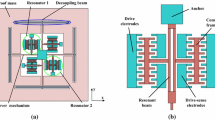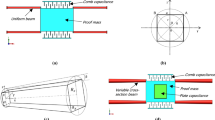Abstract
Coupled effects of an electroplated gold layer and damper holes drilled by Electro Chemical Discharge Machining (ECDM) process on the performance improvement of a quad beam capacitive accelerometer is presented in this paper. A simple quad beam-proof mass configuration with its beams located symmetrically at the centre of all the edges of the proof mass and connected to an outer supporting frame is considered in the present study. For a fixed damping ratio, prime-axis sensitivity of the sensor is increased by the damper holes whereas an electroplated gold layer improves the prime-axis sensitivity, cross-axis sensitivity, and Brownian Noise Equivalent Acceleration (BNEA). Moreover, the increased weight of the proof mass due to an electroplated gold layer further reduces the damping of the device which in turn helps to increase the prime-axis sensitivity more. A new figure of merit called Performance Factor (PF), defined as the ratio of the product of the prime-axis sensitivity and resonant frequency to the cross-axis sensitivity at a fixed damping ratio of 0.7 is used as a quantitative index to evaluate the performance improvement caused by the coupled effects of gold electroplating and ECDM processes. Simulation results show that for a device with damper holes of 8 μm diameter and electroplated gold layer of dimensions 3,000 μm × 3,000 μm × 20 μm, the prime-axis sensitivity is increased by more than 500 times, rotational cross-axis sensitivity and BNEA are reduced by around 10 and 30%, respectively and the PF is improved by around 482 times at a fixed damping ratio of 0.7.












Similar content being viewed by others
References
Bao MH, Yang H, Sun Y, Wang Y (2003) Squeeze-film air damping of thick hole-plate. Sens Actuators A 108:212–217
Bernstein J, Miller R, Kelley W, Ward P (1999) Low-noise MEMS vibration sensor for geophysical applications. J Microelectromech Syst 8:433–438
Chae J, Kulah H, Najafi K (2005) A monolithic three-Axis micro-g micromachined silicon capacitive accelerometer. J Microelectromech Syst 14:235–242
Engesser M, Franke AR, Maute M, Meisel DC, Korvink JG (2009) Miniaturization limits of piezoresistive MEMS accelerometers. Microsys Technol 15:1835–1844
Farahani H, Mills JK, Cleghorn WL (2009) Design, fabrication and analysis of micromachined high sensitivity and 0% cross-axis sensitivity capacitive accelerometers. Microsys Technol 15:1815–1826
Francis EHT, Xu J, Logeeswaran VJ (2000) A differential capacitive low-g microaccelerometer with mg resolution. Sens Actuators A 86:45–51
Hsu TR (2002) MEMS and microsystems-design and manufacture. Tata McGraw Hill Education Private Limited, McGraw-Hill. ISBN 9780070487093
Kal S, Das S, Maurya DK, Biswas K, Ravi Sankar A, Lahiri SK (2006) CMOS compatible bulk micromachined silicon piezoresistive accelerometer with low off-axis sensitivity. Microelectron J 37:22–30
Kampen RPV, Wolffenbuttel RF (1998) Modeling the mechanical behavior of bulk-micromachined silicon accelerometers. Sens Actuators A 64:137–150
Lee Yoon GH, Park J, Seok S, Chun K, Lee KI (2005) Development and analysis of the vertical capacitive accelerometer. Sens Actuators A 119:8–18
Li G, Li Z, Wang C, Hao Y, Li T, Zhang D, Wu G (2001) Design and fabrication of a highly symmetrical capacitive triaxial accelerometer. J Micromech Microeng 11:48–54
Liu C, Brazilai AM, Reynolds JK, Partridge A, Kenny TW, Grade JD, Rockstad K (1998) Characterization of a high-sensitivity micromachined tunneling accelerometer with micro-g resolution. J Microelectromech Syst 2:235–244
Lötters JC, Olthuis W, Veltink PH, Bergveld P (1997) Design, realization and characterization of a symmetrical triaxial capacitive accelerometer for medical applications. Sens Actuators A 61:303–308
Lötters JC, Bomer JG, Verloop AJ, Droog EA, Olthuis W, Veltink PH, Bergveld P (1998) Design, fabrication and characterization of a highly symmetrical capacitive triaxial accelerometer. Sens Actuators A 66:205–212
Madou MJ (2002) Fundamentals of microfabrication: the science of miniaturization. New York, CRC Press
Pandey AK, Pratap R (2004) Coupled nonlinear effects of surface roughness and rarefaction on squeeze film damping in MEMS structures. J Micromech Microeng 14:1430–1437
Ravi Sankar A, Lahiri SK, Das S (2009a) Performance enhancement of a silicon MEMS piezoresistive single axis accelerometer with electroplated gold on a proof mass. J Micromech Microeng 19:1–10
Ravi Sankar A, Das S, Lahiri SK (2009b) Cross-axis sensitivity reduction of a silicon MEMS piezoresistive accelerometer. Microsyst Technol 15:511–518
Riethmuller W, Benecke W, Schnakenberg U, Wagner B (1992) A smart accelerometer with on-chip electronics fabricated by a commercial CMOS process. Sens Actuators A 50:121–126
Rödjegård H, Johansson C, Enoksson P, Andersson G (2005) A monolithic three-axis SOI-accelerometer with uniform sensitivity. Sens Actuators A 123–124:50–53
Rudolf F, Jornod A, Berqvist J, Leuthold H (1990) Precision accelerometers with μg resolution. Sens Actuators A 21–23:297–302
Sim JH, Cho CS, Kim JS, Lee JH, Lee JH (1998) Eight-beam piezoresistive accelerometer fabricated by using a selective porous-silicon etching method. Sens Actuators A 66:273–278
Tsai JZ, Chen CJ, Chen WY, Liu JT, Liao CY, Hsin YM (2009) A new PZT piezoelectric sensor for gravimetric applications using the resonance-frequency detection. Sens Actuators B 139:259–264
Tsuchiya T, Funabashi H (2004) A z-axis differential capacitive SOI accelerometer with vertical comb electrodes. Sens Actuators A 116:378–383
Wang C, Tsai M, Sun C, Fang W (2007) A novel CMOS out-of-plane accelerometer with fully differential gap-closing capacitance sensing electrodes. J Micromech Microeng 17:1275–1280
Xiao F, Lufeng C, Bin X, Yuelin W, Xiaofeng Z, Yufang L, Youling L (2008) A novel capacitive accelerometer with an eight-beam-mass structure by self-stop anisotropic etching of (100) silicon. J Micromech Microeng 18:075005
Yazdi N, Najafi K (2000) An all-Silicon single-wafer micro-g accelerometer with a combined surface and bulk micromachining process. J Microelectromech Syst 9:44–550
Author information
Authors and Affiliations
Corresponding author
Rights and permissions
About this article
Cite this article
Sankar, A.R., Bindu, V.S.S. & Das, S. Coupled effects of gold electroplating and electrochemical discharge machining processes on the performance improvement of a capacitive accelerometer. Microsyst Technol 17, 1661 (2011). https://doi.org/10.1007/s00542-011-1350-7
Received:
Accepted:
Published:
DOI: https://doi.org/10.1007/s00542-011-1350-7




